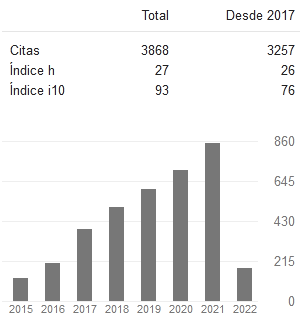Applications of artificial intelligence in Criminalistics
Keywords:
Criminalistics, artificial intelligence, crime investigationAbstract
In recent years there have been technological advances, among the most innovative being artificial intelligence, which has several areas of application, including Criminalistics, which is responsible for clarifying crimes and determining possible crimes. Guilty To carry out their work, criminalists use various methods and techniques that have a scientific basis and proceed to analyze the evidence using multiple tools, which includes artificial intelligence. The application of these systems in criminal investigation is varied as they can be effective and represent a saving of time and resources, in addition to minimizing human errors. Many artificial intelligence tools are already applied in the study of crimes and their use is expected to increase, which is why it is essential to delve deeper into the possible applications of artificial intelligence for criminal investigation because, despite the fact that there are concerns about the use of artificial intelligence, it is evident that its use will increase exponentially in the coming years. This article focuses its attention on the present applications and future potential of artificial intelligence in Criminalistics, having used document analysis methods, analysis, synthesis, induction and deduction, among others, for the investigation. This allowed us to reach conclusions that show the potential of the use of artificial intelligence in the field of Criminalistics and, therefore, in the implementation of justice.
Downloads
References
Aponte, C. (2024). Aplicación de la Inteligencia Artificial en la Investigación Criminal. https://www.academia.edu/104160717/APLICACI%C3%93N_DE_LA_INTELIGENCIA_ARTIFICIAL_EN_LA_INVESTIGACI%C3%93N_CRIMINAL_An%C3%A1lisis_Preliminar_Abg_Carlos_Aponte_Profesor_de_pregrado_y_postgrado_USM_Especialista_en_derecho_penal_USM_Magister_en_derecho_Procesal_UCSG
Barbieri, A. (18 de 03 de 2019). ¿Puede predecirse un crimen antes de suceder con un algoritmo?. La Vanguardia. https://www.lavanguardia.com/tecnologia/20190318/461013536935/inteligencia-artifical-vigilancia-predictiva-policia.html
Barona Vilar, S. (2019). Inteligencia artificial o la algoritmización de la vida y de la justicia: ¿solución o problema?. Revista Boliviana de Derecho, (28), 18-49. https://dialnet.unirioja.es/servlet/articulo?codigo=7026828
Behl, H. (2021). IA: clave para manejar multitud de datos en la investigación forense. Red Seguridad(94), 80-92. https://www.redseguridad.com/especialidades-tic/tecnologias-disruptivas/inteligencia-artificial-clave-para-manejar-multitud-de-datos-en-la-investigacion-forense_20220104.html
Calatayud, J. D. (24 de 05 de 2024). IA para reconstruir escenas del crimen. El Diario. https://www.eldiario.net/portal/2024/05/24/ia-para-reconstruir-escenas-del-crimen/
Comisión Europea. (19 de 2 de 2020). Libro Blanco sobre la inteligencia artificial - un enfoque europeo orientado a la excelencia y la confianza. https://commission.europa.eu/publications/white-paper-artificial-intelligence-european-approach-excellence-and-trust_en
Comité Económico y Social Europeo. (31 de 05 de 2017). Dictamen del Comité Económico y Social Europeo sobre la «Inteligencia artificial: las consecuencias de la inteligencia artificial para el mercado único (digital), la producción, el consumo, el empleo y la sociedad. https://eur-lex.europa.eu/legal-content/ES/TXT/PDF/?uri=CELEX:52016IE5369
Cuatrecasas, C. (2022). La Inteligencia Artificial en el proceso penal de instrucción español: posibles beneficios y potenciales riesgos. [Tesis de doctorado, Universitat Ramon Llull]. https://www.tdx.cat/bitstream/handle/10803/675100/Tesi_Carlota_Cuatrecasas.pdf?sequence=2
Cuatrecasas Monforte, C. (2023). La inteligencia artificial y la investigación de delitos. Logos Guardia Civil, Revista Científica Del Centro Universitario De La Guardia Civil, (1), 61–84. https://revistacugc.es/article/view/5912
De la Torre, A. (22 de 11 de 2022). VALCRI, inteligencia artificial en la investigación criminal. https://investigacioncriminal.es/valcri-la-inteligencia-artificial-al-servicio-de-la-investigacion-criminal/
Dozal, L. F. (2019). De la Inteligencia Artificial y sus aplicaciones. https://aguaardiente.uaa.mx/11/van02.html
Duboust, O. (12 de 01 de 2024). ¿Puede la IA mejorar la investigación forense al encontrar similitudes en las huellas dactilares? Un nuevo estudio desata el debate. Euronews. https://es.euronews.com/next/2024/01/12/puede-la-ia-mejorar-la-investigacion-forense-al-encontrar-similitudes-en-las-huellas-dacti
González, B., Munilla, T. S., Ayala, N. T., y Bartolomé, F. (2022). Usos de Inteligencia Artificial y Machine Learning en Criminología. 9 No Congreso Nacional de Ingeniería Informática. Universidad Tecnológica nacional. https://grupogemis.com.ar/wp-content/uploads/2023/01/IA_Criminologia.pdf
Hernández, M. (2019). Inteligencia Artificial y Derecho Penal. Actualidad Jurídica Iberoamericana (10), 792-843. https://www.revista-aji.com/wp-content/uploads/2019/06/792-843.pdf
Juárez Ponce, E. L. (07 de 06 de 2023). Inteligencia Artificia: aplicación en las ciencias forenses. Hechos y Derechos, (75).https://revistas.juridicas.unam.mx/index.php/hechos-y-derechos/article/view/18260/18561
Larson, J., Mattu, S., Kirchner, L., y Angwin, J. (23 de 05 de 2016). How We Analyzed the COMPAS Recidivism Algorithm. https://www.propublica.org/article/how-we-analyzed-the-compas-recidivism-algorithm
Lozano, J. (21 de 07 de 2023). La inteligencia artificial aplicada a la investigación criminal, todo un reto en la defensa de derechos fundamentales. https://www.garrigues.com/es_ES/garrigues-digital/inteligencia-artificial-aplicada-investigacion-criminal-todo-reto-defensa
Martínez, A. (21 de 11 de 2023). Una nueva herramienta forense permitirá 'leer' rastros mínimos de sangre en la escena de un crimen . El Diario. https://www.eldiario.es/sociedad/nueva-herramienta-forense-permitira-leer-rastros-minimos-sangre-escena-crimen_1_10705544.html
Merlo, G., y Ulloa, J. R. (2023). Inteligencia artificial. Su impacto en la justicia penal y las ciencias forenses: desafíos y oportunidades. Revista Pensamiento Penal(475), 1-11. https://www.pensamientopenal.com.ar/system/files/Documento_Editado1259.pdf
Muñoz, A. (10 de 03 de 2023). Inteligencia Artificial: clave para abordar retos en la informática forense. https://www.pwc.com/co/es/pwc-insights/inteligencia-artificial-retos-informatica-forense.html
Pérez Chávez, P. B. (2021). Inteligencia Artificial y la prueba del periculum libertatis. [tesis de pregrado, Universidad de Barcelona]. https://diposit.ub.edu/dspace/bitstream/2445/179890/5/179890.pdf
Real Academia Española. (2023). Diccionario de la lengua española. https://dle.rae.es/inteligencia
Remolina Angarita, N. (2022). Presentación general de la obra. En Cotino Hueso, L. y Bauzá Reilly, M. (coords.), Derechos y garantías ante la inteligencia artificial y las decisiones automatizadas (pp. 5-16). Thomson Reuters Aranzadi.
Rodríguez, S. D., y Maldonado, L. M. (2024). Reflexión sobre el uso de la inteligencia artificial en la investigación penal en el Ecuador-análisis de su aplicabilidad en el derecho comparado. Polo del Conocimiento, 9(2), 1214-1230. https://polodelconocimiento.com/ojs/index.php/es/article/view/6584
Waldman, A. E. (2019). Power, Process, and Automated Decision-Making. Fordham Law Review, 88(2), 613-632. https://ir.lawnet.fordham.edu/flr/vol88/iss2/9/
Downloads
Published
How to Cite
Conference Proceedings Volume
Section
ARK
License
Copyright (c) 2025 Bryan Mauricio Granda Romero, Jean Max Quezada Quezada, Armando Rogelio Durán Ocampo

This work is licensed under a Creative Commons Attribution 4.0 International License.
Usted es libre de:
- Compartir — copiar y redistribuir el material en cualquier medio o formato
- Adaptar — remezclar, transformar y construir a partir del material para cualquier propósito, incluso comercialmente.
Bajo los siguientes términos:
- Atribución — Usted debe dar crédito de manera adecuada, brindar un enlace a la licencia, e indicar si se han realizado cambios. Puede hacerlo en cualquier forma razonable, pero no de forma tal que sugiera que usted o su uso tienen el apoyo de la licenciante.
- No hay restricciones adicionales — No puede aplicar términos legales ni medidas tecnológicas que restrinjan legalmente a otras a hacer cualquier uso permitido por la licencia.













































